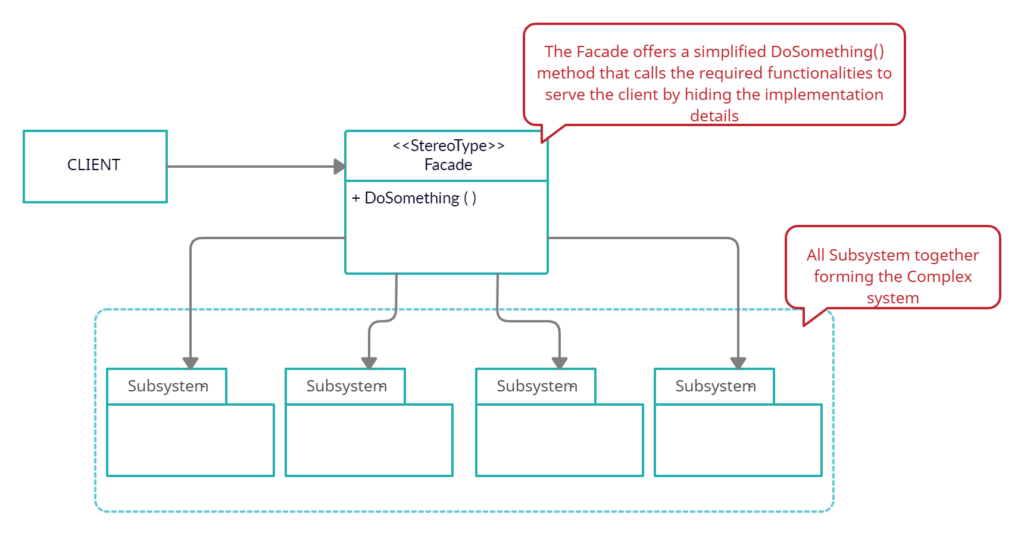Table Of Content

In our example, it will be the Main method of the Program class. So, please modify the Main method of the Program class as follows. Here, the client needs to create an object of the Order class and call the PlaceOrder method to place an order.
Facade Design Pattern in Java
However, it includes only those features that clients really care about. Facade is a structural design pattern that provides a simplified interface to a library, a framework, or any other complex set of classes. The Facade Design Pattern is a structural pattern that provides a simplified interface to a complex system of classes, libraries, or frameworks. The Facade (usually a wrapper) class sits on the top of a group of subsystems and allows them to communicate in a unified manner. One example use of the facade pattern is for integrating a web site with a business application. The existing software may include large amounts of business logic that must be accessed in a particular manner.
The Facade Pattern in Modern Java Frameworks
So, create a class file with the name Payment.cs and copy and paste the following code into it. Whether Net Banking, UPI, or Cash on Delivery, you need to make the payment accordingly. The following Payment class can accept the request from the Facade class or the client directly. As shown in the above image, to place an order first, the Client needs to create an object of the Product class and get the product details by calling the GetProductDetails method.
When to use facade pattern
Each microservice is a separate, self-contained module, but they often need to communicate with each other. A Facade can serve as a gateway, managing and simplifying these inter-microservice communications. Pentalog Connect is your free pass to a large community of top engineers who excel in developing outstanding and impactful digital products. When joining, you receive access to a wealth of resources that will feed your appetite for quality content and your need for professional growth. Tutorials Point is a leading Ed Tech company striving to provide the best learning material on technical and non-technical subjects.
Types of Behvioural Patterns
MVRDV wraps Tiffany & Co.store with coral-inspired 3D-printed façade in Singapore's Changi Airport - World Architecture Community
MVRDV wraps Tiffany & Co.store with coral-inspired 3D-printed façade in Singapore's Changi Airport.
Posted: Mon, 16 Oct 2023 07:00:00 GMT [source]
A visualization of the classes and objects participating in this pattern. But in a facade, subsystems are not aware of the facade and the one-way communication is provided from facade to the subsystem(s). In the adapter pattern, we try to alter an interface so that the clients is able to work with the system. Else the system will be difficult to use by the client (even not usable).
This platform includes numerous subsystems such as user authentication, payment processing, inventory management, and order fulfillment, among others. Let's look at how a Facade pattern can simplify the interactions. Another typical application is software in which the dependency between clients and underlying subsystems is to be minimized. It is important to carefully consider the trade-offs and assess whether the Facade pattern is appropriate for a given system.
2 How will the client program access this façade?
The facade pattern is a wrapper of many other interfaces in a result to produce a simpler interface. Facade hides the complexities of the system and provides an interface to the client from where the client can access the system. A design pattern is a common way of solving a recurring problem. What is important is how they are structured and how they work together to solve a given problem in the best possible way.
When looking for suitable strategies to simplify complex software, one inevitably encounters the facade design pattern or simply facade pattern. This pattern involves one wrapper class which contains a set of methods available for the client. This pattern is particularly used when a system is very complex or difficult to understand and when the system has multiple subsystems. This will be a concrete class, and this class takes the responsibility to place the order. So, create a class file names Order.cs and copy and paste the following code.
It allows users to access the application’s core objects (managers, controllers, and so on), and you can execute common operations. Such a facade is often responsible for instantiating and initializing the main objects and getting the application up and running. You can also use it when you need an entry point to each level of layered software or the system you created is very complex or difficult to understand. A facade should not be described as a class which contains a lot of other classes. It is in fact a interface to this classes and should make the usage of the classes easier otherwise the facade class is useless. Also, what is important while learning design patterns is to be able to recognize which pattern fits your given problem and then using it appropriately.
However, the Mediator is a behavioral pattern, and it describes the way the objects communicate. This is a burger provider class that will get burgers for their clients. The methods can have other private methods which the client is not bothered about.
The Facade design pattern is an integral part of the object-oriented design pattern library, providing a simple, unified interface to a set of interfaces in a subsystem. The Facade pattern, when implemented correctly in Java, can simplify the usage of complex systems and improve code readability, manageability, and maintainability. Its purpose is to hide internal complexity behind a single interface that appears simple on the outside. The facade or the facade class is the decisive structuring unit of the facade pattern. In other words, its implementation and preparation is the fundamental task for developers looking to simplify their complex software by using this handy design pattern.

No comments:
Post a Comment